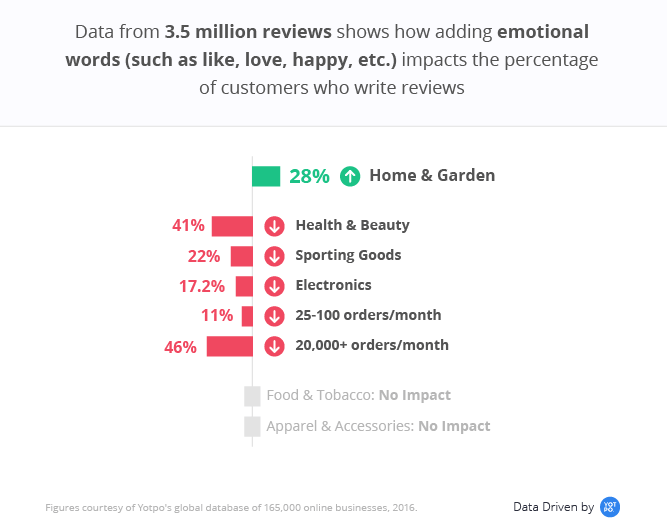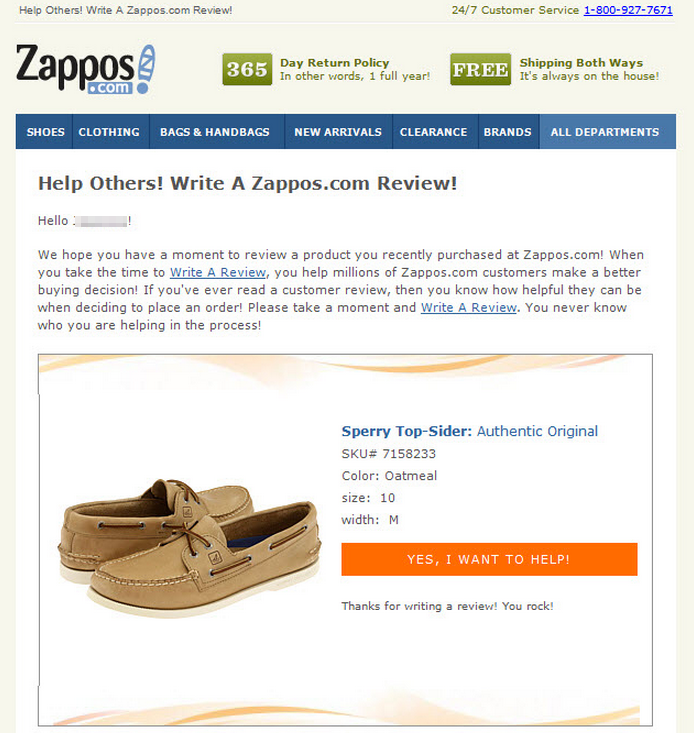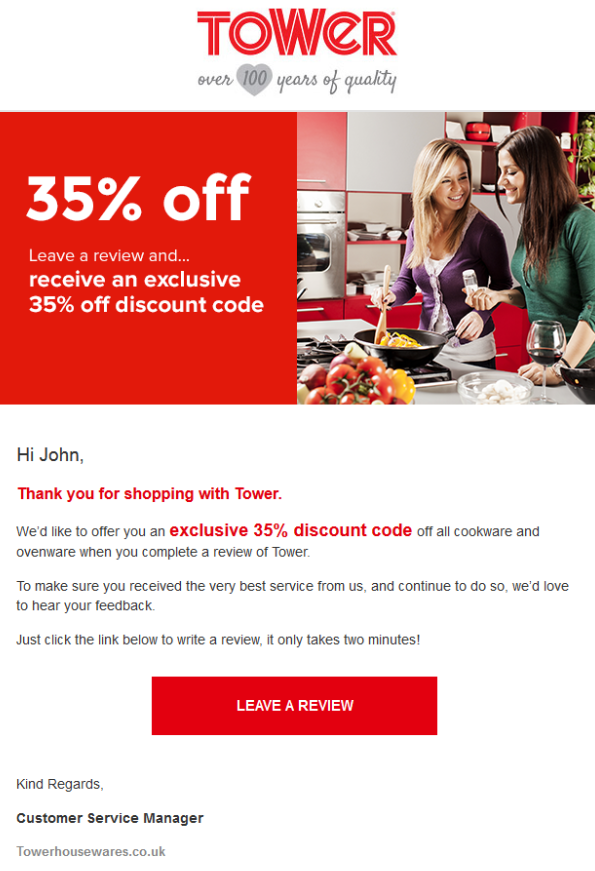7 Ways to Get Product Reviews from Your Ecommerce Customers
For many consumers, their first stop on your product pages is likely to be the customer reviews.
Approximately 70% of consumers consult customer reviews before making a decision on a purchase, and 93% said that customer reviews influence their shopping choices. With so many consumers relying on customer reviews to help them decide what to buy, asking for product reviews is a solid way to drive more ecommerce sales.
So what makes product reviews so influential? It all comes down to what’s known as the Diffusion of Innovation theory. Popularized in 1962 by American sociologist Everett “Ev” Rogers—the same guy who coined the term “early adopters”—the Diffusion of Innovation theory states that new ideas, behaviors, and products aren’t adopted by the majority of a population overnight; they “diffuse” among that population gradually. The farther the product or idea diffuses, the greater the overall adoption rate becomes.
What does this mean in terms of products and product reviews, though? Well, essentially it means that most consumers require at least some social proof or validation before buying a new product or considering a new idea. The number of people who are willing to try new products without this social validation is actually very small:

[Source]
In light of this behavior, it’s vital to demonstrate that your product is desirable to others to help sell your product to prospective customers who need that social validation.
In other words, product reviews help you get past the innovators and the early adopters and get your product in front of the majority of prospective buyers.
As fascinating (and accurate) as Rogers’s theory is, it probably won’t come as much surprise to anyone who’s ever bought anything. The chances are pretty good that you’ve bought something on the strength of a friend’s recommendation, and word of mouth has long been one of the most effective forms of advertising. On average, consumers will spend 31% more money with businesses that have lots of positive customer reviews. In fact, according to BrightLocal, 85% of consumers trust product reviews as much as a personal recommendation—an eye-opening statistic backed up by Nielsen data.
Of course, product reviews offer much more to prospective buyers than social validation does. Product reviews help consumers mitigate risk, gather more information about a prospective purchase, and at least partially reduce the likelihood of experiencing buyer’s remorse.
Put another way, displaying product reviews on your product pages helps your customers feel confident in their decision to buy from you.
Product reviews aren’t great tools just for helping prospective buyers feel good about their decisions; they’re great for SEO, too. Since most product pages are a bit light in terms of actual content—at least compared with, say, the average blog post—they don’t tend to rank well in organic search. And, since relevance is a fundamental part of how search works, including product reviews on your product pages can boost your visibility significantly.
So, now that we’ve established what product reviews are really for and why they’re so awesome, we have to turn our attention to how to actually get them.
You have to ask. For most ecommerce retailers, this means email. Let’s see this in action.
Crafting Irresistible Subject Lines
When commerce-marketing cloud provider Yotpo analyzed 3.5 million email requests for product reviews, they found that, perhaps surprisingly, the inclusion of “emotional” words in subject lines—words such as “happy,” “like,” “love,” and “smile,” for example—did not have a positive impact on whether the recipient actually wrote a product review.
This trend was particularly evident in the Health & Beauty, Electronics, and Sporting Goods verticals, which saw conversions (i.e., recipients writing a product review) as much as 41% lower. Interestingly, the one industry vertical that defied this rule was the Home & Garden vertical, which saw a 28% lift in conversion rates when email requests for product reviews included emotional language in their subject lines.

[Source]
So what else did Yotpo’s exhaustive analysis reveal about product review request subject lines?
- Asking questions in subject lines increases conversion rates by an average of almost 16%.
- The inclusion of exclamation points has virtually no impact on conversion rates—unless you’re selling food or tobacco products, which saw an enormous 83.5% lift in conversion rates when subject lines featured exclamation points.
- In every industry vertical except Electronics, using UPPERCASE type for at least one word in the subject line causes a significant decrease in conversion rates.
- Email subject lines that include words with positive financial connotations—such as “win,” “free,” “discount,” and “save” for example—get 18.5% more reviews on average.
- On average, including the name of the store in an email subject line boosts conversion rates by 3.7%.
Timing Is Everything
Securing product reviews from existing customers also depends on how and when you send your requests. Although this varies from one business to another—and one customer to another—there are two factors you should bear in mind when calculating when to send your product review request:
- How long it takes to process the order and deliver the product to the customer
- How long it takes for the customer to use the product
Let’s say it takes you two business days to process a customer’s order, and another four days to deliver the product to your customer’s home. It wouldn’t make much sense to send a review request two days after you ship the order, so you should adjust your timeline accordingly.
Similarly, if you know that the majority of your customers tend to use a product mostly on weekends, you should account for this and send your review request emails around seven days later to give your customers enough time to actually use the product before asking them to review it.
Personalizing Product Review Request Emails
These days, sending generic email blasts is a great way for your emails to go straight into the trash, unread. Even a little personalization can go a long way. Fortunately, product review requests are already somewhat personalized, based on the factors above, and you’ll only be sending them to customers who’ve actually purchased and used a specific product.
One of the most effective ways to personalize product review request emails is to use the customer’s name and include an image of the product you’re asking them to review. One company that excels at this is online shoe retailer Zappos, which is famous for the quality of its follow-up care and customer service.
The email below shows how far even a little personalization can go, and the inclusion of the image of the product makes it much easier for the recipient to remember and write about their experiences using a product—in this case, a new pair of Sperry Top-Siders:

Not Every Review Will Be Positive—and That’s OK
One of the few drawbacks of asking customers to review your products is that, inevitably, not every review will be positive. It’s only natural that you want every single customer to be delighted by your products, but it’s important to realize and accept that you can’t please everybody.
As tempting as it can be to try to “bump” bad reviews off your product pages, you should resist this temptation and leave negative reviews alone. You don’t want too many bad reviews (obviously), but one or two negative reviews interspersed among your glowing customer testimonials can actually boost your credibility. According to Econsultancy, 68% of consumers actually trust reviews more when there are some negative reviews included on a product page; if every single review is positive, almost one-third of consumers will believe the reviews are fake.
That said, if the majority of your product reviews are negative, it’s probably best to temporarily suspend the visibility of your product reviews until you can determine why so many customers are unhappy.
Make It As Easy As Possible for Customers to Review Your Products
Like every email campaign, your product review requests should make it practically effortless to review your items. The easier it is for customers to leave reviews, the more likely they will do so.
It might sound redundant, but product review request emails should have a singular focus: getting the customer to review your product. As such, don’t confuse the recipient by asking for multiple things or risk diluting the impact of your email by bundling product review requests with any other promotions, special offers, or content. Similarly, don’t waste time trying to be overly empathetic with your customers by going on and on about how much you value their support. Instead, politely but firmly get right to the point.
Your product review request emails should have a single, crystal-clear call to action that links directly to the page where the customer should leave their review. Don’t ask them to find anything on their own, and don’t confuse them by sending them to multiple pages or asking them to navigate complex menus. Remember, you’re trying to remove as many barriers to leaving a review as you can.
The product review request email below from online baked-goods retailer The Biscuiteers is a perfect example of how to keep the focus solely on reviewing the product. The email itself is clearly branded—but not in an obnoxious or intrusive way—and there’s absolutely no confusion about the purpose of the email or what it’s asking of the recipient:

Sweeten the Deal with Bonus Incentives
Even if your customer is a die-hard evangelist for your company, you should still try to offer your customers additional incentives for leaving reviews of your products. Why? Because you’re still asking customers to take time out of their busy day to essentially do you a favor. Including bonus incentives such as discount coupons or free shipping can be a powerful motivation, and it reinforces customers’ positive views of your company.
If you choose to include bonus incentives for reviewing your products, make sure to put the offer front and center in your product review request emails, like British housewares retailer Tower does in the example email below:

Another way to tempt your customers into leaving a product review is to run a sweepstakes giveaway or another type of contest or competition. Admittedly, the chance to win something might not be as compelling as a straightforward discount offer, but it may be persuasive, depending on the nature of your products and the types of customers you typically target.
One thing to bear in mind if you opt for the discount-coupon route is to use such incentives sparingly. Discounting your merchandise too heavily or frequently risks devaluing your products or brand in the eyes of your customers, so exercise caution. It’s also worth remembering that coupons or discounts aren’t suitable for every product line, so if your customers wouldn’t expect a discount as an incentive, don’t offer one.
Ask and Ye Shall Receive
One of the first things that new sales professionals learn on the job is that you rarely close a deal without explicitly asking for a customer’s business—and the same principle applies to asking customers to review your products.
Product review request emails are simple and straightforward by design, which makes them conveniently easy to A/B test. As such, it shouldn’t take much time or effort to split-test your emails and optimize your campaigns for your products and customers. Once you’re satisfied, all that’s left to do is send those emails to your adoring public and wait for the praise to roll in.
Latest posts by David Candelas (see all)
- Use a SMART Goal Template to Hack Your Productivity - December 11, 2020
- Is LinkedIn Worth Your Time as a Salesperson? - November 24, 2020
- Tips for Starting the Home Office of Your Dreams - November 29, 2019

